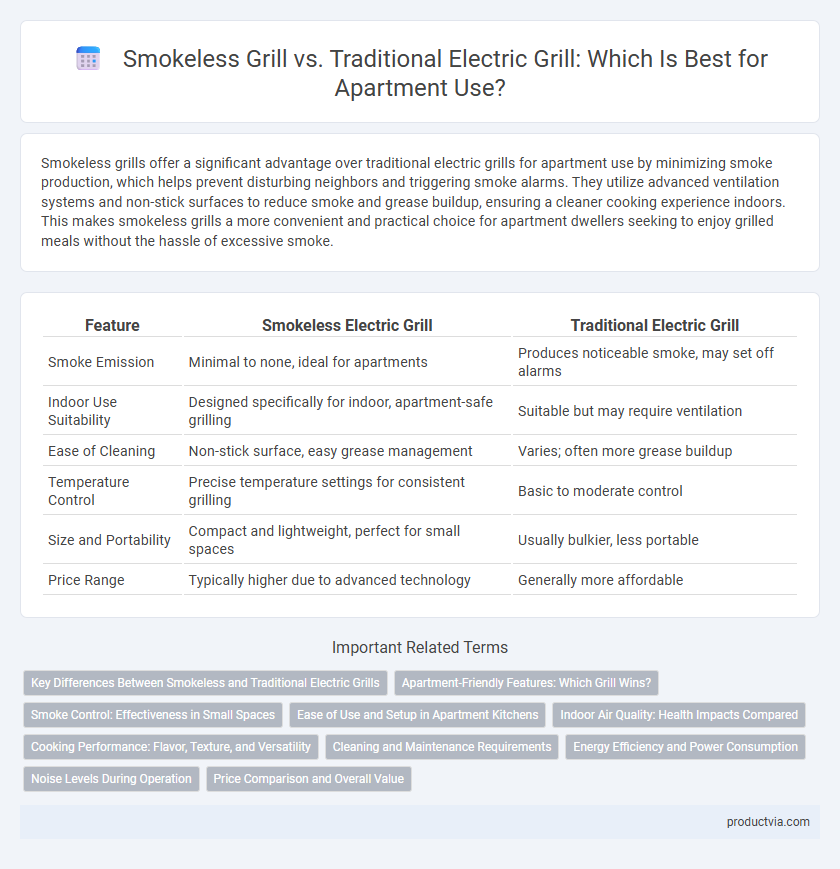Smokeless grills offer a significant advantage over traditional electric grills for apartment use by minimizing smoke production, which helps prevent disturbing neighbors and triggering smoke alarms. They utilize advanced ventilation systems and non-stick surfaces to reduce smoke and grease buildup, ensuring a cleaner cooking experience indoors. This makes smokeless grills a more convenient and practical choice for apartment dwellers seeking to enjoy grilled meals without the hassle of excessive smoke.
Table of Comparison
| Feature | Smokeless Electric Grill | Traditional Electric Grill |
|---|---|---|
| Smoke Emission | Minimal to none, ideal for apartments | Produces noticeable smoke, may set off alarms |
| Indoor Use Suitability | Designed specifically for indoor, apartment-safe grilling | Suitable but may require ventilation |
| Ease of Cleaning | Non-stick surface, easy grease management | Varies; often more grease buildup |
| Temperature Control | Precise temperature settings for consistent grilling | Basic to moderate control |
| Size and Portability | Compact and lightweight, perfect for small spaces | Usually bulkier, less portable |
| Price Range | Typically higher due to advanced technology | Generally more affordable |
Key Differences Between Smokeless and Traditional Electric Grills
Smokeless grills use advanced ventilation and heat distribution technology to minimize smoke production, making them ideal for apartment use where ventilation is limited. Traditional electric grills often generate more smoke due to direct contact with heating elements and less efficient grease management. Smokeless models also tend to have non-stick surfaces and built-in drip trays that reduce grease buildup, enhancing indoor air quality and cleaning convenience.
Apartment-Friendly Features: Which Grill Wins?
Smokeless grills outperform traditional electric grills in apartment settings due to advanced ventilation systems that reduce smoke and odor, making them ideal for indoor use. Their compact design and automatic temperature controls enhance safety and convenience in confined spaces, aligning with strict apartment building regulations. These apartment-friendly features position smokeless grills as the preferred choice for urban dwellers seeking a clean and efficient cooking experience.
Smoke Control: Effectiveness in Small Spaces
Smokeless grills utilize advanced infrared heating elements and improved ventilation systems to significantly reduce airborne smoke particles, making them highly effective for apartment use where smoke control is crucial. Traditional electric grills often produce more visible smoke and lingering odors due to less efficient smoke extraction, which can be problematic in confined indoor spaces. Choosing a smokeless grill enhances air quality and minimizes ventilation issues, providing a safer and more comfortable cooking environment in small apartments.
Ease of Use and Setup in Apartment Kitchens
Smokeless grills offer significant advantages in ease of use and setup for apartment kitchens due to their built-in smoke reduction technology, which minimizes ventilation requirements. Traditional electric grills often require additional exhaust solutions or open windows to mitigate smoke, complicating their use in confined spaces. The compact design and straightforward controls of smokeless grills make them ideal for hassle-free cooking without the need for extensive smoke management.
Indoor Air Quality: Health Impacts Compared
Smokeless grills reduce indoor air pollution by minimizing smoke and particulate emissions, which significantly lowers the risk of respiratory issues compared to traditional electric grills that often produce more airborne contaminants. Improved indoor air quality with smokeless grills helps prevent irritation of the eyes, throat, and lungs, making them safer for apartment environments where ventilation may be limited. Choosing a smokeless grill supports healthier living conditions by ensuring cleaner air and reducing exposure to harmful pollutants.
Cooking Performance: Flavor, Texture, and Versatility
Smokeless grills use advanced ventilation and non-stick surfaces to reduce smoke production without compromising the caramelization and searing that enhance flavor and texture, making them ideal for apartment use. Traditional electric grills often produce more smoke but can offer higher heat levels for more pronounced grill marks and a smokier taste, suitable for versatile cooking methods like searing, grilling, and roasting. Both grill types support cooking a variety of foods, but smokeless models excel in maintaining indoor air quality while still delivering consistent results.
Cleaning and Maintenance Requirements
Smokeless grills for apartment use require less frequent cleaning due to advanced drip trays and smoke filtration systems that reduce residue buildup. Traditional electric grills often accumulate grease and char, necessitating more intensive scrubbing and regular disassembly of grill plates. Choosing a smokeless grill can significantly lower maintenance time and effort, making it ideal for small living spaces with limited cleaning resources.
Energy Efficiency and Power Consumption
Smokeless grills typically consume less power, averaging around 1000-1500 watts, compared to traditional electric grills that can use up to 1800 watts, making them more energy-efficient for apartment living. Their advanced heating elements and better heat retention technologies reduce overall electricity usage while maintaining consistent cooking temperatures. This efficiency helps minimize energy bills and reduces heat output, essential for confined apartment spaces.
Noise Levels During Operation
Smokeless grills significantly reduce noise levels compared to traditional electric grills, making them ideal for apartment use where quiet operation is essential. Traditional electric grills often produce a constant humming sound from heating elements and fans, which can be disruptive in small living spaces. Opting for a smokeless grill ensures a more peaceful cooking environment without sacrificing performance or convenience.
Price Comparison and Overall Value
Smokeless grills typically cost 20-30% more than traditional electric grills, reflecting their advanced ventilation and filtration technology designed to reduce smoke emissions, which is ideal for apartment use. Traditional electric grills offer lower upfront prices but may lead to increased ventilation expenses or discomfort due to smoke accumulation in confined spaces. Considering overall value, smokeless grills provide better long-term convenience and maintain indoor air quality, making them a cost-effective investment for apartment dwellers despite the higher initial price.
Smokeless grill vs traditional electric grill for apartment use Infographic

 productvia.com
productvia.com